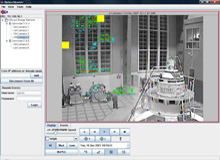 |
| CCTV-based Video Smoke Detection (VSD) from D-Tec provides safety for Ireland's Electricity Supply Board (ESB) |
This approach to fire detection utilises standard CCTV images in real-time that can then be analysed by specialised image processing software. This seeks out the particular pattern that smoke produces by applying extensive detection and known false alarm algorithms. The ability to effectively detect smoke at source, unlike more traditional methods, means that VSD does not have to rely on the proximity of smoke to a detector and is therefore unaffected by distance. Whether the camera is situated 10 metres or 100 metres from a risk area, VSD has the capacity to detect smoke in the same amount of time, providing an early warning that would be impossible with conventional detection as it is not waiting for the smoke to reach the camera.
When it comes to Video Smoke Detection, the Republic of Ireland's Electricity Supply Board (ESB) - which is 95% government owned - has been close to this technology for nearly a decade now and boasts what is reckoned to be, the largest installed base of power stations covered by Video Smoke Detection anywhere in the world.
Currently there are seven ESB stations monitored by Video Smoke Detection. These include: Aghada (gas), Ardnacrusha (hydro), Marina (gas), Moneypoint (coal), Northwall (oil/gas), Poolbeg (oil/gas) and Dublin Bay (part ESB owned). Over the years two additional stations have featured VSD, namely Great Island -
Ireland's seven Electricity Supply Board (ESB) stations are monitored by D-Tec CCTV-based video smoke detection |
Before turning to Video Smoke Detection, according to Kevin Grace from Safety Services at ESB looked they carefully at a number of other options: "Prior to 2000 Safety Services tried out, what was then one of the latest techniques, specifically, high sensitivity smoke detectors which were being promoted at the time as being able to cope with dirty environments typical of power stations. However in the case of ESB they simply did not work. This was due in part to the high propensity for smoke to diffuse in what are extensive, high roofed, turbine halls."
Having been unable to achieve the necessary performance, the next step for the Safety Services team was to consider more radical solutions such as CCTV-based Video Smoke Detection (VSD).
Said Kevin Grace: "At the request of Safety Services, in conjunction with D-Tec, an intensive test project was established at Wexford's Great Island power station. This necessitated smoke pellets being set off in the turbine area of the station to carefully simulate the effects of a fire. After the VSD system had settled in and been configured, and reconfigured, it was possible to achieve a detection rate in line with the time parameters Safety Services were looking for i.e. within a minute. The test was considered a great success and led ultimately to the roll-out of VSD across our thermal stations from 2000 onwards."
 |
| In ESB power stations, the VSD system is used in conjunction with standard B&W CCTV cameras |
Typically, in ESB power stations, the VSD system is used in conjunction with standard B&W CCTV cameras all of which have hoods in place to help keep them clean of the dirt and grime which can build up.
Commented Kevin: "From my perspective a key benefit with Video Smoke Detection is the immediate visual indication of what is happening when the alarm and associated image - with the area of interest highlighted - is displayed in the control room."
"There is the reassurance that incidents will be flagged-up, at the earliest possible stage, so preventative action can be taken. In addition to the obvious potential for injury to personnel or the loss of life, the possibility of a facility going off-line, unexpectedly, is a real nightmare scenario for any generator. The greatest fear of all is undoubtedly a major fire which could literally take away capacity for months or even years. Thankfully with VSD we are now well placed to stop this becoming a reality."


















